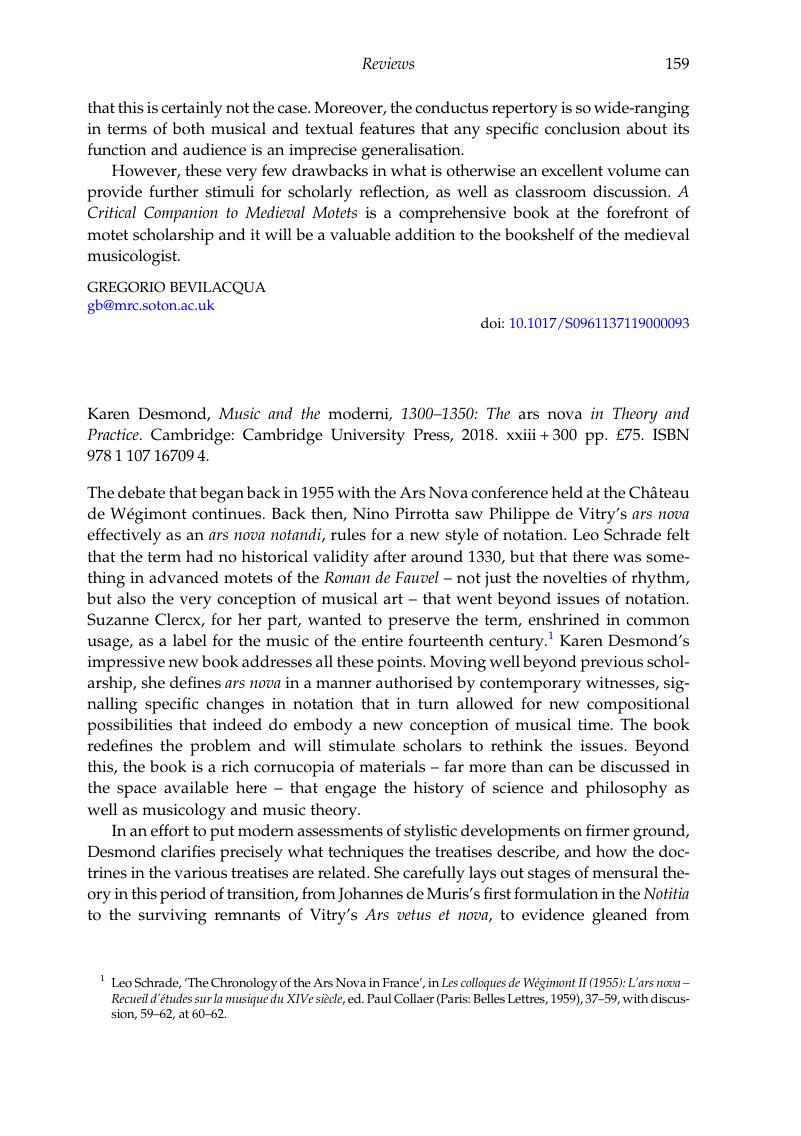No CrossRef data available.
Article contents
Karen Desmond, Music and the moderni, 1300–1350: The ars nova in Theory and Practice. Cambridge: Cambridge University Press, 2018. xxiii + 300 pp. £75. ISBN 978 1 107 16709 4.
Published online by Cambridge University Press: 11 October 2019
Abstract

- Type
- Reviews
- Information
- Copyright
- Copyright © Cambridge University Press 2019
References
1 Schrade, Leo, ‘The Chronology of the Ars Nova in France’, in Les colloques de Wégimont II (1955): L'ars nova – Recueil d’études sur la musique du XIVe siècle, ed. Collaer, Paul (Paris: Belles Lettres, 1959), 37–59Google Scholar, with discussion, 59–62, at 60–62.
2 Jacobus directly quotes from a partially lost written treatise by Vitry; see Desmond, Karen, ‘Did Vitry Write an Ars vetus et nova?’, Journal of Musicology, 32/4 (2015), 441–93CrossRefGoogle Scholar.
3 Michels, Ulrich, Die Musiktraktate des Johannes de Muris, Beihefte zum Archiv für Musikwissenschaft 8 (Wiesbaden, 1970), 50–5Google Scholar.
4 Three short unedited treatises likely by Muris can be placed on circumstantial evidence in the period c.1326 to 1332. One of these is an early version of the Compendium, which therefore came later. On this, see Desmond, Karen, ‘Jean des Murs and the Three Libelli on Music in BnF lat. 7378A: A Preliminary Report’, Erudition and the Republic of Letters, 4 (2019), 40–63CrossRefGoogle Scholar. Christian Meyer had proposed separating the Notitia (1319) from the Conclusiones (1321) some time ago; see Jean de Murs: Écrits sur la musique, ed. and trans. Christian Meyer (Gap, 2000), 10.
5 For further on the dating of Jacobus, see Bent, Margaret, Magister Jacobus de Ispania, Author of the ‘Speculum musicae’, Royal Musical Association Monographs 28 (Farnham, 2015), 53–61Google Scholar.
6 At times Desmond translates ‘grosso modo’ as ‘crude and unrefined’ (p. 35; cf. p. 17, 68). In a review, Sarah Fuller fruitfully compares two translations of this passage and suggests a third; see Notes (Music Library Association), 2nd series, 48/2 (1991), 473–75, at 474.
7 See Leech-Wilkinson, Daniel, Compositional Techniques in the Four-Part Isorhythmic Motets of Philippe de Vitry and his Contemporaries, 2 vols. (New York and London, 1989), 1: 160–2Google Scholar; and Kügle, Karl, The Manuscript Ivrea, Biblioteca Capitolare 115: Studies in the Transmission and Composition of Ars Nova Polyphony, Musicological Studies 69 (Ottawa, 1997), 140–7Google Scholar.
8 de Ispania, Jacobus, The Mirror of Music Book the Seventh, trans. Wegman, Rob C. (Lexington, KY, 2017)Google Scholar, ch. 24, p. 43. The Latin is ‘Nam quidam illarum quasdam syncopabant, quasdam autem interius semiplenas figurabant’ (Jacobi Leodiensis, Speculum musicae, vol. 7, ed. Roger Bragard, Corpus Scriptorum de Musica 3 (Rome, 1973), ¶5, p. 51).
9 Many of these signs are found among the examples in Handlo's Regule (1326), a treatise that Jacobus apparently knew (see Desmond, ‘Did Vitry Write an Ars vetus et nova?’, p. 456 and 466 Table 3). On Handlo and the signum rotundum, see Lefferts, Peter M., ed. and trans., Robertus de Handlo The Rules and Johannes Hanboys The Summa: A New Critical Text and Translation (Lincoln, NE and London, 1991), 110–15Google Scholar.
10 The passage in Jacobus is translated by Wegman, in Jacobus de Ispania, The Mirror of Music, 42.
11 That Muris carried out astronomical observations for Jeanne de France, queen of Navarre at her château ‘Navarre’ at Evreux gives a new twist to the indication in the Quatuor principalia that the minim was invented ‘in Navarina’ (p. 71 n. 6).
12 Whole sections of the Omni desideranti, which Desmond considers likely by Vitry, reappear in the Libellus; see Desmond, Karen, ‘Texts in Play: The Ars nova and its Hypertexts’, Musica Disciplina, 57 (2012), 81–153Google Scholar, at 90–3.
13 On satire and irony in Speculum Book 7, see Hentschel, Frank, ‘Der Streit um die ars nova – nur ein Scherz?’, Archiv für Musikwissenschaft, 58/2 (2001), 110–30CrossRefGoogle Scholar. This article can be added to Desmond's very ample bibliography.
14 Desmond cites a passage in Jacobus to bolster the notion that moderns were in a state of confusion over semibreves. This passage in its context, however, concerns mixing imperfect and imperfect modus and tempus (p. 121 and n. 21).
15 The quotation is translated by Wegman, in Jacobus de Ispania, The Mirror of Music, ch. 23, p. 42.
16 Compare, as one example, the characterisation of Vitry's Colla / Bona on pp. 146–7 with the characterisation on p. 212.




